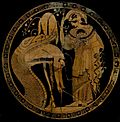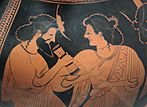Greek mythology facts for kids
Greek mythology is a collection of amazing stories that were first told by the ancient Greeks. These myths are a big part of their old folklore.
These stories help explain:
- How the world began and what it's like.
- The lives of gods, heroes, and mythical creatures.
- The reasons behind the ancient Greeks' religious practices and rituals.
Today, people still study these myths. They help us understand the ancient Greeks' beliefs and how they saw the world.
You can find these Greek myths in old writings. Famous examples include Homer's long poems, the Iliad and the Odyssey. They also appear in other poems, plays, and writings from the Roman Empire era by authors like Plutarch.
Ancient Greek art also shows these stories. You can see gods, heroes, and mythical scenes on vases and other ancient objects.
Greek mythology has greatly influenced Western culture, art, and literature. Even today, artists and writers get ideas from these old stories. They find new meanings in the classic themes.
Contents
How We Know About Greek Myths
We learn about Greek mythology mainly from Greek writings and art. These sources date back to around 900 BC. Both the written stories and the pictures on ancient objects help us understand these myths. Sometimes they even tell slightly different versions of the same story!
How the World Began
"Origin myths" or "creation myths" explain how the universe started.
A popular version comes from a writer named Hesiod. He said that everything began with Chaos. This was a huge, empty space. From Chaos came Gaia (the Earth) and other early gods like Eros (Love) and Tartarus (the Underworld).
Gaia then gave birth to Uranus (the Sky). Gaia and Uranus had many children. First came the Titans. There were six male Titans and six female Titans. Some famous Titans include Cronus and Rhea.
After the Titans, Gaia and Uranus had other children. These included the one-eyed Cyclopes and the Hundred-Handed Ones. Uranus threw both of these groups into Tartarus. This made Gaia very angry. She convinced her son, Cronus, to attack his father. Cronus did this and became the new ruler of the Titans. His sister, Rhea, became his queen.
The Rise of the Gods
Cronus was afraid that his own children would betray him, just as he had betrayed his father. So, every time Rhea gave birth, Cronus would grab the baby and eat it! Rhea hated this. When her son Zeus was born, she tricked Cronus. She hid Zeus and gave Cronus a stone wrapped in a baby's blanket, which he swallowed.
When Zeus grew up, he gave Cronus a special drink. This drink made Cronus throw up all of Rhea's other children. These included Poseidon, Hades, Hestia, Demeter, and Hera. He also threw up the stone he had swallowed.
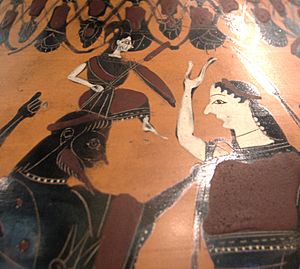
Zeus then challenged Cronus to a big war for control of the gods. With help from the Cyclopes (whom Zeus freed from Tartarus), Zeus and his siblings won. Cronus and the other Titans were thrown into Tartarus.
Later, Zeus learned that his first wife, Metis, would have a child stronger than him. So, Zeus swallowed Metis. But she was already pregnant with Athena. Athena then burst out of Zeus's head, fully grown and ready for battle!
The Greek Gods
After the Titans were defeated, a new group of gods and goddesses took over. These were the Olympians. They lived on Mount Olympus and Zeus was their leader.
Besides the Olympians, Greeks also worshipped other gods. These included Pan, the satyr-god of the countryside. There were also Nymphs, who were spirits of nature. Naiads lived in springs, Dryads in trees, and Nereids in the sea. River gods and Satyrs were also important. The Greeks also believed in dark powers of the underworld, like the Erinyes (Furies). These Furies would chase anyone who committed crimes against their own family.
The gods in Greek mythology looked like perfect humans. They had many amazing powers. They could not get sick, and it was very hard to hurt them. The Greek gods were also immortal, meaning they lived forever. They stayed young by constantly eating nectar and ambrosia.
Most gods were connected to certain parts of life. For example, Aphrodite was the goddess of love and beauty. Ares was the god of war, and Hades ruled the underworld. Athena was the goddess of wisdom and courage. Some gods, like Apollo and Dionysus, had many different roles. Others, like Hestia (goddess of the hearth), were simpler.
The most impressive temples were built for a few main gods. People from all over Greece would worship them. During the age of heroes, people also worshipped heroes, who were like demigods.
The Age of Heroes
The time when heroes lived is called the Heroic Age.
One of the most famous heroes was Heracles. Other early heroes included Perseus, Theseus, and Bellerophon. Like Heracles, they often went on solo adventures. They fought monsters like the Chimera and Medusa. A common theme in these stories was sending a hero on a dangerous mission that was supposed to kill them. This happened to Perseus and Bellerophon.
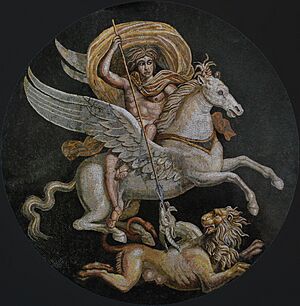
Heracles and His Descendants
The amazing adventures of Heracles are seen as the start of the age of heroes. Three other big events happened during this time: the Argonautic expedition, the Theban Cycle (stories about Thebes), and the Trojan War.
Heracles was the son of Zeus and Alcmene. His many incredible adventures, which often felt like folk tales, gave rise to many popular legends.
The Argonauts
The Argonautica is a long poem that tells the story of Jason and the Argonauts. They sailed on a ship called the Argo to find the Golden Fleece in the mythical land of Colchis.
King Pelias sent Jason on this quest. Pelias had heard a prophecy that a man with one sandal would be his enemy. Jason lost a sandal in a river and then arrived at Pelias's court. This started the whole adventure. Many famous heroes of that time, including Heracles and Theseus, joined Jason on the Argo. Theseus was the hero who went to Crete to kill the Minotaur. Atalanta was a famous female heroine.
In ancient times, people thought the Argonauts' journey was a real historical event. It was seen as part of the Greeks exploring the Black Sea. This story was very popular, and many local legends became connected to it. The story of Medea, in particular, was a favorite for playwrights.
The Trojan War
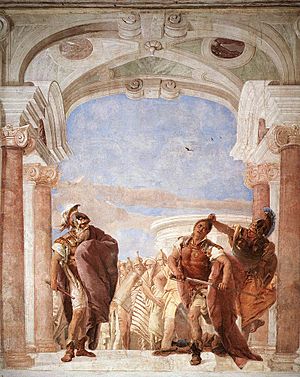
Greek mythology reaches its peak with the Trojan War. This was a huge war fought between Greece and Troy.
The stories of the Trojan War begin with events leading up to it. These include Eris and the golden apple, the Judgement of Paris, and the kidnapping of Helen. To get Helen back, the Greeks launched a massive expedition. Menelaus's brother, Agamemnon, led the Greek army. But the Trojans refused to return Helen.
Homer's Iliad tells about the tenth year of the war. It focuses on the fight between Agamemnon and Achilles, who was the best Greek warrior. This quarrel led to the deaths of Achilles' friend Patroclus and Troy's greatest hero, Hector.
After Hector's death, the Trojans got help from two powerful allies. These were Penthesilea, the queen of the Amazons, and Memnon, the king of the Ethiopians. Achilles killed both of them. But then Paris managed to kill Achilles with an arrow to his heel. Achilles' heel was the only part of his body that could be harmed.
Before they could take Troy, the Greeks had to steal a special wooden statue of Athena called the Palladium. Finally, with Athena's help, they built the Trojan Horse. The Trojans were tricked into bringing the horse inside their city walls. They thought it was an offering to Athena. A Greek named Sinon pretended to have deserted and convinced them. The priest Laocoon tried to warn them, but sea-serpents killed him.
At night, the Greek fleet returned. The soldiers hidden inside the Trojan Horse opened the city gates. The Greeks then completely destroyed Troy. King Priam and his remaining sons were killed. The Trojan women were taken as slaves to different Greek cities.
The adventurous journeys home for the Greek leaders were told in other stories. These included the long travels of Odysseus (in Homer's Odyssey) and Aeneas (in the Aeneid). The Trojan War stories provided many ideas for ancient Greek artists and later European writers.
Some of the most famous heroes from the Trojan War were:
On the Trojan side:
On the Greek side:
- Ajax (there were two heroes named Ajax)
- Achilles
- King Agamemnon
- Menelaus
- Odysseus
How Greeks and Romans Saw Myths
Mythology was a central part of daily life in Ancient Greece. Greeks believed their myths were part of their history. They used these stories to explain natural events, different cultures, and why certain groups were friends or enemies. It made them proud to say their leaders came from a mythological hero or a god. Few people doubted that the stories of the Trojan War in the Iliad and Odyssey were true. Homer's poems were like a textbook for Greece.
Myths in Art and Books Today
Even when Christianity became popular, the myths stayed well-known. During the Renaissance, people rediscovered ancient Greek and Roman culture. The poems of Ovid, a Roman writer, greatly influenced artists and writers. Artists like Leonardo da Vinci, Michelangelo, and Raphael painted scenes from Greek mythology alongside Christian ones.
Greek myths influenced writers like Petrarch and Dante in Italy. In England, writers from Chaucer to Shakespeare used Greek myths in their works. In France and Germany, writers like Racine and Goethe brought back Greek plays. Even during the 18th century, when some people were less interested in myths, they still provided ideas for plays and operas by composers like Handel and Mozart.
By the late 1700s, a new interest in all things Greek, including mythology, began. This was called Romanticism. In Britain, new translations of Greek plays and Homer's poems inspired poets like Alfred Tennyson and Keats. Painters like Lord Leighton also found inspiration. Composers like Christoph Gluck and Richard Strauss set Greek myths to music.
American writers in the 1800s, like Thomas Bulfinch and Nathaniel Hawthorne, believed that studying classical myths was key to understanding English and American literature. More recently, modern writers like James Joyce have retold classical themes in new ways.
Images for kids
-
The Roman poet Virgil, shown in a fifth-century manuscript. He kept many Greek myths alive in his writings.
-
Plato in Raphael's famous painting, The School of Athens.
-
Cicero was a Roman statesman. He was skeptical about myths but still defended the traditional order.
See also
 In Spanish: Mitología griega para niños
In Spanish: Mitología griega para niños



